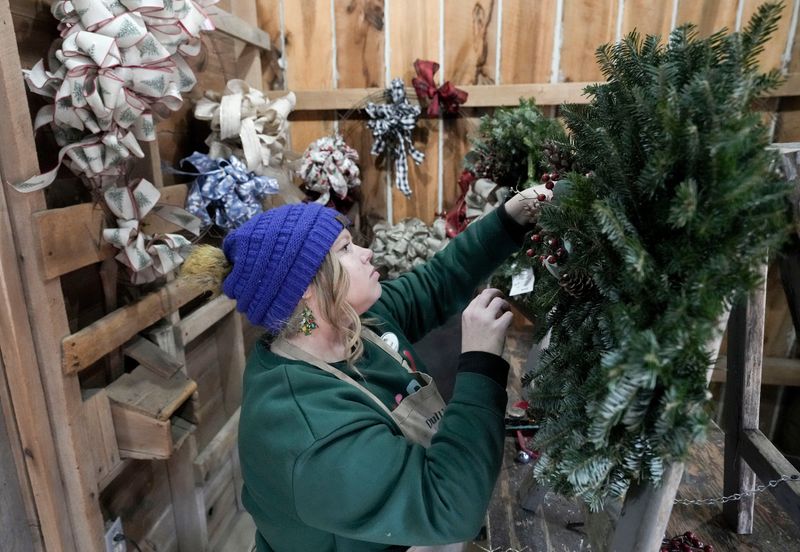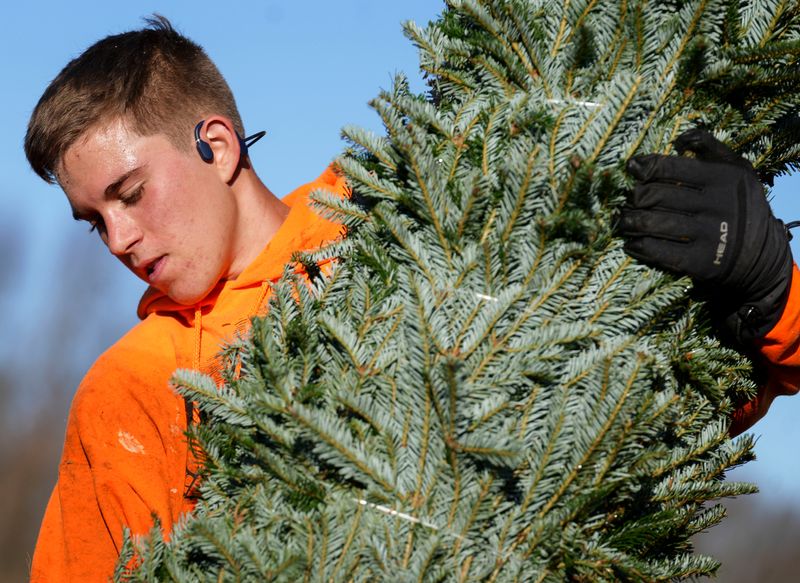‘Tis the season for Tannenbaum. It’s just a matter of which one.
The choices can seem overwhelming at first: Will a blue spruce fill the house with the sharp scent of balsam better than a white pine? Will a 15-foot fir fit in the living room, and what colored lights should you drape on its needles this year?

Beyond the aesthetics, you might wonder if it’s more eco-friendly to cut down a real tree or purchase an artificial one. We dug into the debate to find out which option is more sustainable.
The case for artificial trees
Over the next month and a half, Christmas tree farmer Tom Dull expects to see more than 25,000 people walk through the grounds of Dull’s Tree Farm. Various species of evergreen trees, ranging from three to 16 feet tall, sit in neat rows across 65-acres nestled in the rolling hills of Thorntown, Indiana. Many folks who visit the farm this season will leave with one of the trees in tow.
Dull is convinced that real trees like his are more environmentally-friendly than artificial ones.
“It’s an easy argument to win,” he said, adding real Christmas trees are “recyclable, they’re renewable, they’re good for wildlife.”
However, Dull acknowledged, some people have an aversion to chopping down real trees year after year. Looming threats of climate change and headlines with news of deforestation might mar the twinkling memories of stooping in the snow, surrounded by family, to saw through the trunk of a living tree.
But Christmas tree farms aren’t exactly forests under siege; they’re actual farms. And the 65,000 trees on Dull’s farm that store carbon, breathe out oxygen and create habitat for wildlife might not have existed if Dull’s first dream — to be a hog farmer — worked out.
Still, many environmentalists argue that agriculture and development are leading drivers of habitat loss in Indiana and the Midwest. More than 14 of Indiana’s 23 million acres were cultivated as cropland in 2022, according to the Indiana State Department of Agriculture, and 448 native plant species are endangered or threatened in the state.
Although he did not deliberately set out to do so, Dull created a wildlife habitat on his tree farm, something a hog farm would likely never have accomplished. Dull and his employees have seen deer, coyotes, foxes, rabbits, quail, mice, snakes — and once, even a bobcat — snaking through the fields of pine, fir and spruce.
Dull, whose species of choice is a concolor fir, said that he plants more trees than his customers chop down. He expects to sell around 6,500 trees this year and plant 10,000 more in 2026.
The case for artificial trees
Jami Warner, the executive director of the American Christmas Tree Association (ACTA), a trade group representing the artificial Christmas tree industry, thinks that the carbon footprint of either type of tree is “really quite small,” especially when you consider how long consumers keep artificial trees.
“An artificial tree is an investment. It is something you use year after year. It’s the epitome of sustainability,” she said. “Our members have customers who have kept their trees for years and years and years, and they pass them down from generation to generation. They become sort of heirlooms.”
Much of a real tree’s environmental impact comes from its disposal, so an artificial tree’s long lifespan works in its favor in the battle for the greenest tree award.
An assessment commissioned by the ACTA in 2017 showed that buying an artificial tree has a “more favorable effect on the environment” than real trees if kept for at least five years, Warner said.
But transportation emissions — artificial trees are often imported from China — and the plastic manufacturing required to replicate small green pine needles still concern consumers. Warner said some companies, like Balsam Hill, are leaning into new technology, such as plant-based plastics, but most artificial trees are still made from steel and resin.
Buying a new artificial Christmas tree each year probably isn’t as eco-friendly as buying a live one annually, but Warner said she thinks most Americans keep their artificial trees for around a decade.
And for some folks, an artificial tree is the only option.
Families living in small apartments, people with limited mobility or someone worried about fire safety might prefer an artificial tree. In fact, more than 80% of the country does, according to the ACTA.
Evergreen disposal matters
Perhaps the most environmentally impactful part of a tree’s life cycle, real or artificial, is where it is laid to rest.
On Dull’s tree farm, some trees that don’t get sold are tossed into the property’s pond where they create habitat and offer protection for the fish, Dull said.
In his eyes, the plastic of artificial Christmas trees makes the real thing far superior.
“You buy a fake tree; it’s made out of petroleum,” he said. “You throw it away; it stays a landfill for who knows how long.”
Despite a rising demand for artificial trees, the real Christmas tree industry still woos a fair amount of Hoosiers: there are more than 200 Christmas tree farms in Indiana, creating habitat for wildlife in agricultural parts of the state and supporting local economies. Dull’s Tree Farm employs more than 170 locals during the pumpkin and Christmas tree seasons, including many young people.
In the true holiday spirit, Warner thinks choosing the right tree all comes down to personal preference and circumstance.
“There is no such thing as a bad Christmas tree,” she said. “They’re all beautiful. Real, artificial. Charlie Brown, tall, short, one-sided, multicolored, whatever. There is a perfect Christmas tree out there for everyone.”
IndyStar’s environmental reporting is made possible through the generous support of the nonprofit Nina Mason Pulliam Charitable Trust.
Sophie Hartley is an IndyStar environment reporter. You can reach her at sophie.hartley@indystar.com or on X at @sophienhartley.
This article originally appeared on Indianapolis Star: Fake vs. real Christmas tree: One smells better but is it more environmentally friendly?
Reporting by Sophie Hartley, Indianapolis Star / Indianapolis Star
USA TODAY Network via Reuters Connect




